Insects attack all parts of the maize plant and attack the plant through all stages of plant growth. Numerous insect species attack maize in North America but the economic importance of the various species differs by region. The insects discussed are grouped according to the plant parts that they feed on: 1) Seed, Root and Lower Stem Feeders 2) Leaf Feeders and 3) Ear Feeders. This section examines seed, root, and lower stem feeders.
A failure in emergence expressed in skips along the rows indicates a potential problem with seed attacking insects. The most common insect pests attacking the maize seed are the seedcorn maggots, wireworms, and seedcorn beetles. Wireworms and white grubs attack the maize root system throughout the growing season and may be found in the soil at any time of the year. Rootworms feed on the plant roots from mid season to late mid season. Billbugs, chinch bugs and black cutworms feed on the lower portion of the stem.
The following insects are discussed:
- Seed Corn Maggot
- Seed Corn Beetles
- Wireworms
- White Grubs
- Billbugs
- Chinch Bug
- Black Cutworm
- Corn Root Aphid
- Western Corn Rootworm
- Northern Corn Rootworm
- Southern Corn Rootworm
Seed Corn Maggot
Description
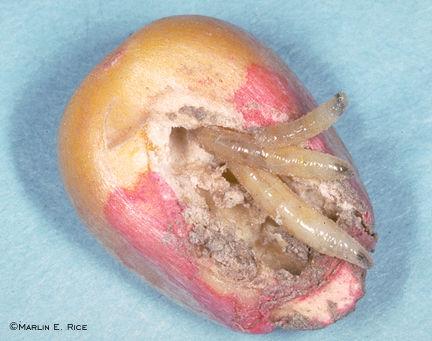
Seedcorn maggots, Hylemya platura (Meigen), are larvae of small flies that are attracted to germinating seeds, especially in situations having decaying organic matter. Since the seed maggots are larvae of flies, they have no legs and are similar to fly maggots in a manure pile. The seedcorn maggot is a yellowish-white larva that reaches a length of 7 mm (see figure). The larva has a rounded tail that tapers to a sharply pointed head, giving it a spindle shape. It has black hook-like mandibles. After the maggot stage, it changes into a brown capsule-like puparium, then matures into an adult fly. The gray, blacklegged fly resembles a house fly, but is only half as large (5 mm) and folds its wings over the body when at rest. Eggs are small, white and elongated.
Biology and Life Cycle
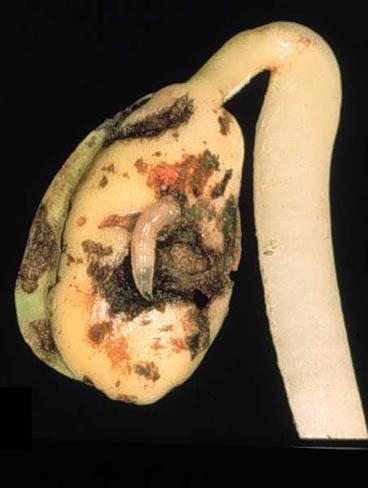
The seedcorn maggot passes the winter as a pupa in the soil. Adults emerge from the overwintering pupae in the late spring or early summer to lay eggs in soils high in decaying organic matter (muck soils or fields with abundant weeds, stubble or manure that have been plowed down). Adults deposit their eggs near the seed. The seed furrow may have some turned under vegetation that attracts the egg laying females. The longer the seed takes to germinate, the longer it is susceptible to attack by the seedcorn maggot. As a result, cold wet soils tend to have more problems with the seedcorn maggot than other soils. The maggots hatch in 2 - 4 days and the maggots readily burrow into germinating maize. These maggots mature into puparia after about two weeks. Adults emerge from puparia in about 2 weeks. There are 4 - 5 generations per year, but only the first generation is a significant problem on maize.
Damage
A failure in the emergence of seedlings that is evident as missing plants along the rows indicates a potential problem with seed attacking insects. Seedcorn maggot damage is obvious because the maggots will be present and boring into the seeds. Seedcorn maggots damage both sprouting seeds (soor germination. Problems due to seedcorn maggot problems are generally worse on soils with decaying organic matter or when germination is delayed, such as during cool, wet springs. Unlike the spotty nature of wireworm or white grub damage, seedcorn maggot damage may cover most of the field.
Seedcorn Beetles
Description
Seedcorn beetles are small ground beetles about 6 -8 mm in length that feed on maize. Two species of seedcorn beetles occur in the field. The seedcorn beetle, Agonoderus lecontei Chaud. (left figure) is oblong and dark with two dark stripes on its wing coversand the slender seedcorn beetle, Clivinia impressifrons LeConte (right figure) is a uniform chestnut brown (or shiny reddish-brown) and spiny front legs.
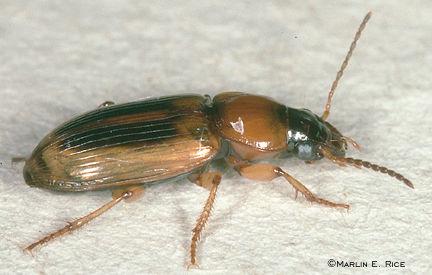
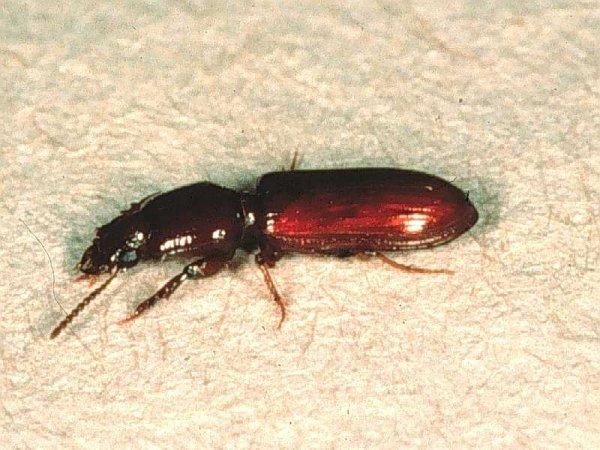
Biology and Life cycle
Seedcorn beetles are distributed throughout the USA and into Canada. The slender seedcorn beetle is common in the Corn Belt states. Seedcorn beetles are assumed to overwinter in the pupal or adult stage. Adult activity fluctuates throughout growing season due to the fact that these beetles pass through a number of generations per year. Adults are attracted to lights where they may be abundant on warm spring evenings. The larvae are predacious on other insects and regarded as beneficial.
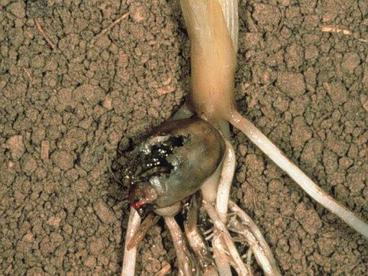
Damage
The damaging stage of the seedcorn beetle is the adult. They attack germinating maize seed and destroy the germ. Holes into or hollowed out seeds (see figure) with dead or stunted sprouts can be seen. Missing plants are a sign of damage. Adults can be seen inside the damaged seed, or in the surrounding soil. They also feed on the mesocotyl of seedling plants causing stunting. These plants will usually recover after reaching the 3 or 4-leaf stage. Seedcorn beetles are most likely to be found under the same conditions and in the same areas that are infested with wireworms or seedcorn maggots. Probability of damage by seedcorn beetles is increased by poor or slow germination and cool, wet weather following planting.
Wireworms
Description
Wireworms (several species of the order Coleoptera, family Elateridae) are larvae of a group of beetles commonly called click beetles. Wireworm larvae are hard (heavily chitinized), wire-like and buff to reddish brown (left figure). Although the several species that attack maize are similar in appearance, they can vary greatly in size from 13 to 38 mm long when fully grown. They have three pairs of legs just behind the head. The dark adult (right figure) is referred to as a "click beetle" because, when placed on its back, it flips into the air making an audible click when righting itself.
Biology and Life cycle
The larval stage of wireworms requires from two to five years or more to complete development. The variation in time required varies between species. Larvae spend the winter deep in the soil, moving up to feed or pupate as soil temperatures warm. In contrast to the long period of larval development, the pupae and adult stage require only a few months. Larvae pupate in earthen cells and adults emerge in the spring or in late summer, depending on the species. Adults lay eggs in grassy areas. Eggs hatch in about 2 weeks. The tiny larvae that hatch from these eggs feed on the roots of grasses and other weeds until fall when they burrow deeper into the soil for hibernation. Because some species can take 4 - 6 years to complete a generation, wireworm damage can occur in a particular field for several years.
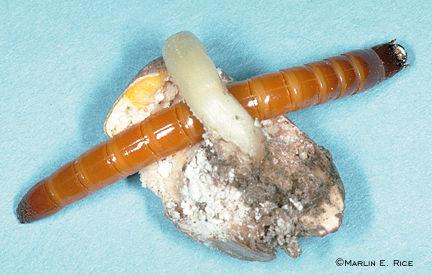
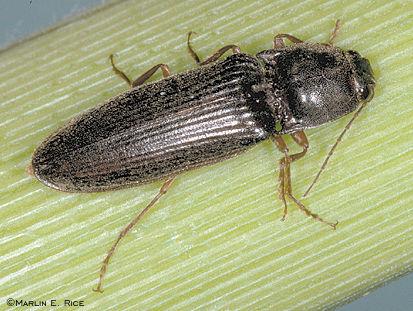
Damage
Since grasses are the primary host plant of various wireworm species, wireworm problems affecting maize are most likely to occur when infested pastures or alfalfa sod are plowed under and planted to maize. Because of their extended life cycles, wireworm damage may persist 2-3 years after a sod is tilled. The most significant damage occurs to germinating seeds and seedling plants during cold, wet springs. Like seedcorn maggots, they also leave behind empty seed hulls as well as snipped-off roots. Wireworm injury is often associated with a small feeding hole at the base of the plant, which may kill the growing point and stunt plant growth.
White Grubs
Description
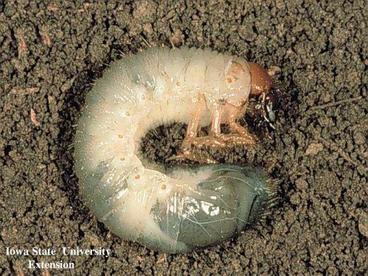
The larvae of scarab beetles are commonly called white grubs and consist of species in the Phyllophaga, Cyclocephala, and Popillia genera. White grubs have brown heads, three pairs of legs just behind the head, and white, thick, soft bodies that curl into a C-shape when disturbed (figure). These C-shaped larvae range in size from 18 mm to more than 38 mm in length if straightened out. The tip of the abdomen is shiny and transparent and body contents are seen through the skin. They move very sluggishly. The common white grub, Phyllophaga sp.,can be distinguished by 2 parallel rows of spines, which are located in the center of the underside of the last abdominal segment. The annual white grubs, Cyclocephala spp. have a uniform distribution of setae (hairs) on the underside of the last abdominal segment while the larvae of the Japanese beetle, Popillia japonica have 2 rows of spines in an inverted "V"-pattern. Adult stages of the common white grubs, Phyllophaga spp. are called May or June beetles. Adult May or June beetles are reddish-brown (left figure) or black (right figure) in color. If grubs are found in abundance and the larvae are all less than an 25 mm in length, the grubs are probably larvae of the Japanese beetle, Popillia japonica Newman.
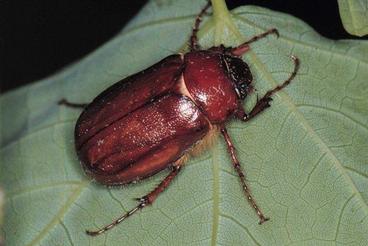
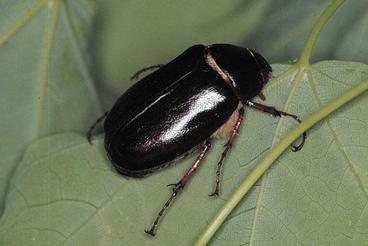
Biology and Life cycle
The life cycle of the common white grubs may be 2, 3, or 4 years, but a 3-year life cycle is most common. Adults deposit eggs on the soil surface of grass sod during late spring. Following a few weeks in the egg stage, the eggs hatch into larvae that feed on plant roots or decaying vegetation near the soil surface. When cool autumn temperatures arrive, larvae tunnel downward in the soil to about 46 cm, to overwinter. Most white grub damage is caused during the second year when these larger larvae return to the surface in the spring to feed voraciously on plant roots. The larvae or grubs continue to feed until they pupate in the late summer and emerge as adults. Some species have a longer life cycle and will feed for a third year before changing into adult beetles.
Annual white grubs and Japanese beetles have 1-year life cycles. Eggs are laid in the soil in June and July. The grubs feed on decaying organic matter or on grass roots until October, when they burrow down further into the soil. They move upward in the spring and resume feeding on roots. The grubs pupate in May and emerge as adults in a few weeks.
Damage

White grub damage is usually patchy, resulting in plant stunting or death. Grub damage results in a general pruning of the root system. Plants with severely pruned roots may grow no more than 0.5 m tall and can be easily lifted from the ground. Lodging and stand reduction occurs in heavy infestations. Damage is usually spotty, rather than being uniform throughout the field. Small areas may be entirely destroyed while other areas are not affected. This may be due to variations in soil texture, which affect egg laying by the beetles.
Billbugs
Description
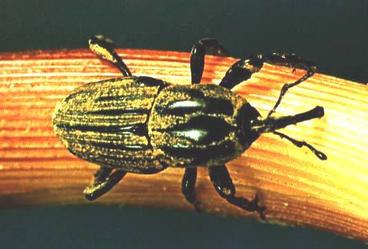
There are several species of billbugs that damage maize in North America. Three species present in the Midwest are the maize billbug Sphenophorus maidis Chittenden, southern corn billbug S. callosus (Olivier), and clay-colored billbug S. aequalis Gyllenhal. The maize billbug (figure at left) is 8 mm long and is the most common of the three species. The southern corn billbug (figure below, left) and the clay-colored billbug (figure below, right) are much larger, up to 20 mm. All three species are characterized by a very hard body and a long, downward curved beak. Adults are often so covered with dirt that they resemble a small clod. They are often found attached upside down to seedling cornstalks near the ground line. The cream colored, kidney-shaped egg is about 3 mm long and 1 mm in diameter.
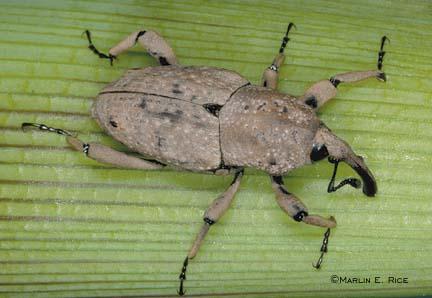
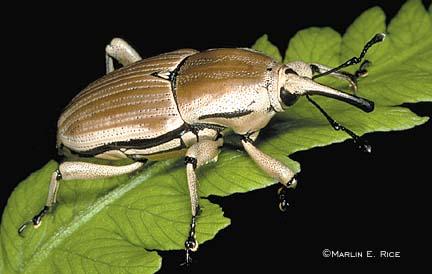
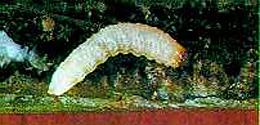
The grub is cream colored, legless and with a distinct reddish-brown head (figure, left). Billbug larvae range from 2 to 15 mm long. The pupa is cream colored to reddish-black, or reddish-brown, depending on its age.
Biology and Life Cycle
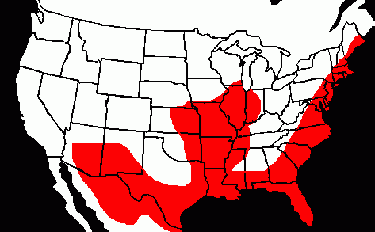
Billbugs are found throughout the most of the maize growing regions of the United States (figure below). The overwintering adults rarely fly but may walk 1/4-mile in search of food. They emerge during April and May from litter in fields, ditches and hedgerows. Each female feeds, mates and lays about 200 eggs, usually at night. They are laid in holes chewed out by the female in the basal area of the host plant. In 4 to 15 days, tiny legless, grublike larvae hatch, migrate down the outside of root crowns, and feed in roots and lower stalks. There is usually only one larva per cornstalk though as many as five have been known to attack the same stalk. The larvae develop in 40 to 70 days and pupate in the soil around the excavated taproot or in a cell in the taproot. Most pupae occur from July to September. Adults develop in 7 to 10 days and either remain within pupal cells or emerge to feed before hibernation. There is only one generation per year. When startled, billbugs often act as though they are dead by falling to the ground and not moving for several minutes. This behavior, plus the fact that they are usually dusted with soil, makes them difficult to find.
Damage
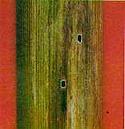
Billbugs are early-season seedling pests that seldom cause economic damage. But billbugs can kill seedling plants and significantly reduce stands if their populations are large. Both billbug adults and larvae injure maize. The adult weevils feed on the lower stems of maize seedlings up to the 6-leaf stage, especially on plants along field edges. They chew small holes into the stalk (figure left) where they eat the tender leaves in the center. When the leaves emerge, they often wilt and are riddled with transverse rows of circular or linear holes. A single beetle may kill a seedling plant. Less injured plants may only exhibit small holes in the leaves as they expand. The perforated leaves often fall or curl so as ; to interfere with the growth of the following leaves (figure right). Plants may be killed. Those that live are stunted and deformed, often with twisted leaves and numerous tillers or suckers around the base of the stalk. Billbug larvae tunnel in the base of the stalk, causing further stunting of the plant. Extensive damage is generally restricted to non-rotated maize fields or to areas adjacent to the previous year's maize. Injury may occur most frequently in fields recently put into production, especially in low, wet areas.
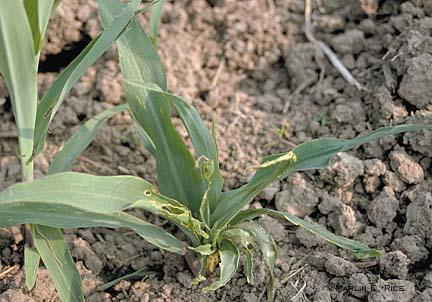
Chinch Bug
Description
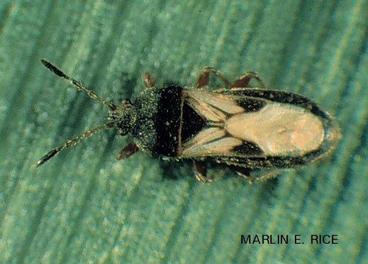
The adult chinch bug, Blissus leucopterus (Say), is about 5 mm long and black with red to reddish yellow legs (figure). The opaque wings may be as long as the body or 1/3 to 1/2 the length of the body. In either case, each wing bears a distinctive, triangular, black mark. The cylindrical yellowish eggs are approximately 0.84 x 0.30 mm, and flattened at one end which bears three to five nipple-like projections. Eggs are laid behind leaf sheaths on the lower leaves. The egg gradually changes in color from pale yellow to red before hatching. The wingless nymph is smaller than, but similar in shape, to the adult. The head and thorax are brown; the eyes are dark red; and the abdomen is pale yellow or light red with a black tip and a band of white on the back just behind the wing pads. Nymphs become dark-colored with a small white patch between the wing pads, as they grow older.
Biology and Life Cycle
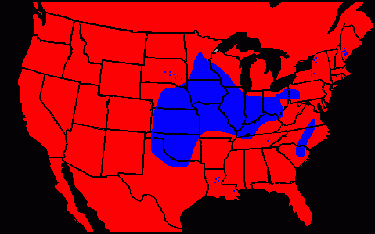
The chinch bug is found throughout the United States, southern Canada, and Mexico. The blue areas in the map indicate historical outbreak locations. Chinch bugs overwinter as adults in various protected areas, particularly among weeds and grasses near fields. Up to 5,000 bugs may be found in a square foot area in preferred hibernating places. Adults emerge in the spring when temperatures pass 70 F. for several hours during which the sun is shining. Adults deposit eggs singly behind the leaf sheath or in the soil at the base of the plant. They lay a few eggs each day for up to a month for a total of about 200 eggs per female. In a few days, the eggs hatch and the nymphs begin feeding on all parts of the host plant from the roots to the uppermost leaves. The nymphs undergo six developmental stages, the last being the adult stage. Development to the adult stage takes about a month. Two to three generations occur per year, the later generations migrating to maize and sorghum when small grain crops become dry.
Damage
Chinch bugs attack a wide range of plant species including forage, lawn, wild grasses and crop plants. The principal crop plants damaged are maize, spring barley, wheat, sorghum, Sudan grass, rye, and timothy. The chinch bug is found from the East Coast into the western plains of Nebraska, Kansas, Oklahoma, and Texas. Most injury is caused by the nymphal stage. Chinch bugs injure maize by sucking juices from maize leaves, stalks, and leaf sheaths. Infested plants first exhibit wilted, white lower leaves (figure, left). Feeding prevents normal growth and results in dwarfing, lodging, and yield reduction. In heavy infestations, entire plants may turn white and wilt. The injury resembles severe frost injury. Heavy infestations frequently destroy the outer rows that border small grain fields.

Black Cutworm
Description
The color of the black cutworm, Agrotis ipsilon (Hufnagel) larva (figure below, left) varies from light gray to black in color, often appearing greasy. The skin is granulated (as seen under a hand lens), the granules resembling rounded, flattened pebbles. Above the spiracles, the larva is basically one color, varying from light gray to nearly black. There is an indistinct pale stripe on the back. The spiracles are distinctly black. There are six instars ranging from 4 to 46 mm in length. When disturbed, the larva curls up. The brown pupa is about 17 to 22 mm long, with distinct mouthparts and antennae. Pupae taper posteriorly and are blunt at the head end. The nocturnal moth (figure, right) is characterized by long, narrow, usually dark forewings that are pale near the tips. There are three black dashes on each forewing. Hind wings are white with dark veins and broad, dark, indefinite margins. The wingspan varies from 38 to 51 mm. The egg is white, round, and about 0.5 mm in diameter.
Biology and Life Cycle
Cutworms that attack maize in Nebraska can be divided into two general categories based on seasonal life cycles. Black cutworms do not overwinter in Nebraska. Dingy, claybacked, darksided, sandhills, pale western, and other species overwinter as partially grown larvae in the soil.
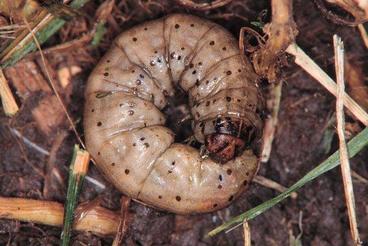
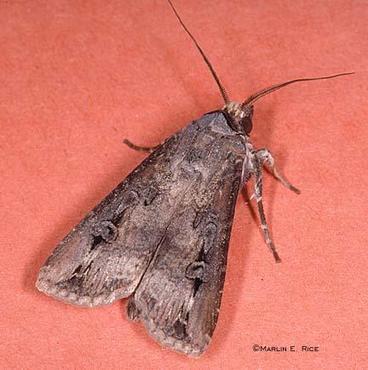
The black cutworm is a widespread species that can be found from southern Canada throughout the United States, Mexico, and South America. Northern regions of the United States must be recolonized each year by migrating moths from southern regions. Since black cutworms do not overwinter in the northern regions, they are dependent on spring weather conditions, primarily southeasterly winds, to bring them into the region. Devastation of maize by the black cutworm is most often reported in the region east of the Mississippi River and in the contiguous states west of this boundary.
The black cutworm feeds on a wide range of field and garden crops. Other known hosts include asparagus, bean, beet, cabbage, castor bean, cotton, grape, lettuce, peanut, pepper, potato, radish, spinach, squash, strawberry tobacco and tomato. Eggs are laid on grasses and weeds before maize is planted. When weeds are destroyed by cultivation or herbicides, the black cutworm larvae migrate to newly emerged maize.
In the south, where the black cutworm overwinters, there are several generations annually. In Tennessee there are four generations. Moths of the first or overwintering generation emerge between the middle of March and the first of May. They mature about the middle of May. Second generation moths emerge from the latter part of May to the middle of July. Third generation moths emerge between the middle of July and the last of August. Fourth generation moths make their appearance near the first of September and continue to emerge into December; they produce the overwintering generation.
Between 5 and 11 days after emergence, each female begins to deposit about 1,300 eggs in clusters of 1 to 30. Most eggs are laid on low, densely growing plants like chickweed, curly dock, and mustard; maize is among the least attractive of the oviposition hosts. The egg stage lasts 3 to 16 days, depending upon the temperature. These cutworms prefer moist soil where they are usually found in tunnels 8 to 10 cm beneath the surface. The destructive larval stage varies in duration from 3 weeks. The pupal stage lasts about 2 weeks for early summer generation; later generations require as much as 8 or 9 weeks.
Damage
It is extremely rare to experience cutworm problems in continuous maize because maizestubble is not a preferred egg laying site. Potential problems in continuous maize may be the result of planting in no-till or weedy maize fields, planting maize following soybeans that had an abundance of winter annual or perennial weeds, planting maize in poorly drained areas, or an interseeding of a fall cover crop such as rye. These cultural practices result in the attraction of egg laying moths to the maize field. Black cutworms are among the most destructive of all cutworms. Leaf feeding by cutworms usually occurs before cutting is observed. The larvae sever plants near the soil line. After cutting a seedling, the black cutworm commonly pulls it into the entrance of its burrow and feeds on it during the day. Some larvae move from plant to plant on successive nights, while others stay to feed on the roots and underground stems of cut plants. Although there is more than one generation per year, the first is the only one that causes significant damage to maize.
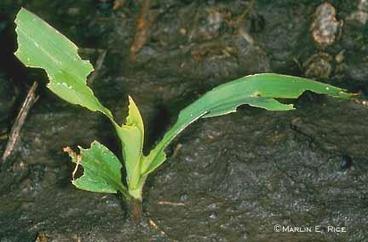
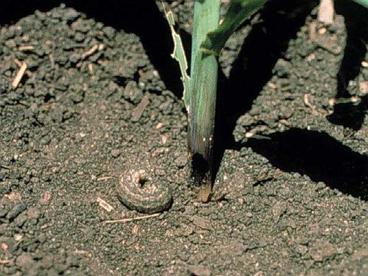
Corn Root Aphid
Description
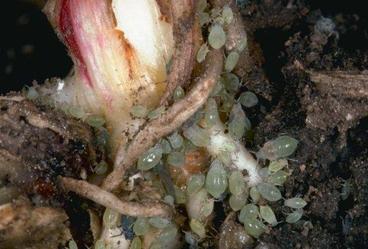
The corn root aphid, Anuraphis maidiradicis (Forbes) adult is typically wingless, spherical, pale green or blue-green, and has a black head and black or reddish eyes. There are 4 different forms in the adult stage: the male, the egg-laying female, and the winged and wingless females that give birth to living young. The female in the egg- laying period has a gray body with a pink abdomen and a white, powdery coating. Length varies from 0.3 mm for small nymphs to 2.0 mm for mature adults. The dark green, oval-elongate egg is less than 1 mm long. The pale green nymph has red eyes, resembles the adult in shape.
Biology and Life Cycle
Although generally distributed, the corn root aphid is most prevalent throughout the maize- and cotton-growing areas east of the Rocky Mountains (figure below). Maize, cotton, and smartweed roots seem to be the most common hosts of the corn root aphid. Other hosts include broomcorn, crabgrass, dock, foxtail, knotweed, mustard, pigweed, plantain, purslane, ragweed, sorghum, sorrel, squash, and wheat.
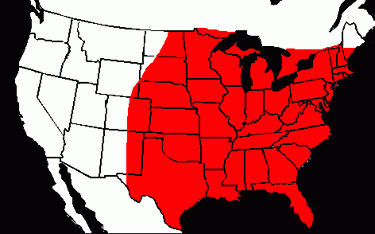
Throughout their life cycle, corn root aphids are highly dependent upon ants, especially cornfield ants. In most areas, at least in the northern areas, the aphids overwinter as eggs deep within the ant nest. In spring, ants carry newly hatched nymphs to the roots of maize or weeds, particularly dock and smartweed. If maize seedlings are available, aphids are transferred to them either from the over-wintering nest or from weeds. Later the ants feed on the honeydew produced by the aphids. First-generation aphid nymphs feed on roots for 2 to 3 weeks before developing into wingless female adults. By-passing the egg-laying stage, these mature aphids soon give birth to 40-50 live nymphs. As summer approaches and temperatures increase, nymphs may mature in as few as 8 days. After several generations, winged female aphids often appear and fly to nearby fields, especially maize or cotton. After landing on anthills, they are carried to the roots by ants. Here the aphids continue to feed and reproduce as before until the approach of cold weather. In the fall, wingless male and female forms develop, mate, and are responsible for the production of overwintering eggs. These eggs are protected from the cold by the ants which carry them deep into their nests. The number of annual aphid generations varies greatly with latitude and environmental conditions. In no-till maize, 10 to 22 generations per year may occur.
Damage
Successive crops of maize, availability of spring host plants and a favorable environment for the cornfield ant are key factors determining the populations of the corn root aphid. Maize infested by the corn root aphid germinates normally, and plants reach a height of 4 to 10 inches, when growth becomes retarded, especially during dry years. Clinging to the maize roots are many bluish-green aphids about the size of pinheads when full grown. The corn root aphid pierces roots with its needle- like mouth parts and extracts sap. As a result of aphids' feeding, the foliage develops a characteristic yellowish to reddish tinge before the maize is knee-high. Heavily infested seedlings rarely grow taller than 25 cm (10 inches). In addition to these symptoms, infested fields are likely to harbor many anthills around the maize plants. The presence of anthills, however, does not necessarily imply infestation by the corn root aphid.
Western Corn Rootworm
Description
Three kinds of rootworms attack corn in the Corn Belt -- the western, the northern, and the southern. The western (Diabrotica virgifera virgifera LeConte), and the northern (Diabrotica barberi Smith & Lawrence), are the most damaging. The southern, Diabrotica undecimpunctata howardi Barber is less damaging and annually migrates from the south in the spring. It does not overwinter in the northern portion of the Corn Belt. Adults of the western corn rootworm are yellow with a dark stripe on the outside edge and center of each wing cover (figure left). Males and females differ somewhat in their markings. On the males, nearly the entire posterior half of each wing cover is black, whereas in the female, the dark stripes are more pronounced. They are about 4 to 6 mm long. Larvae are a creamy-white color with reddish-brown heads.
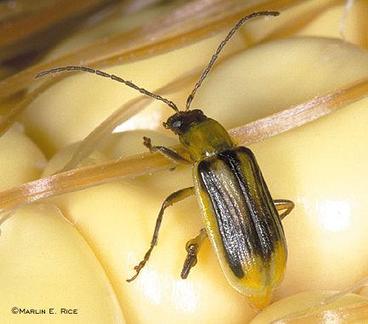
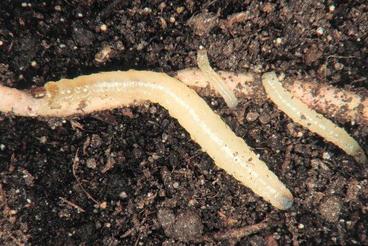
Biology and Life Cycle
The western corn rootworm, D. virgifera virgifera was once restricted to Colorado, Nebraska, and Kansas but in the early 1960's it spread throughout most of the Corn Belt (figure below). The western corn rootworm has one generation per year. Adults emerge from pupae in the soil and feed on silks and pollen. The female beetles lay 300 to 400 eggs in the upper 5 to 20 cm of soil among the roots of maize during later summer and early fall. Eggs are usually deposited in the same fields where the adults feed. Western corn rootworm eggs pass the winter in the soil and hatch the next Spring in late May and early June. The start of hatching depends to some extent on soil temperatures and continues for several weeks.
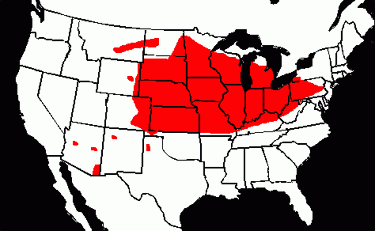
Some of the western corn rootworm eggs may not hatch until the second spring due to "extended diapause", a resting period during which the insect does not develop. After hatching late in the spring, the larvae first feed on young roots of maize or other grass hosts. After the larvae finish feeding, they change to the pupal stage in pupal cells in which they change into the adult, or beetle stage. The pupal stage requires 5 to 10 days before transformation to the adult stage. After emergence, the adults feed for about 2 weeks before the females start laying eggs. Depending on climatic soil conditions, the period from egg hatch to adult emergence requires 4 to 6 weeks. Western corn rootworm beetles usually begin to emerge from the soil in late June, and continue to emerge until September. They are active in fields until frost.
Damage
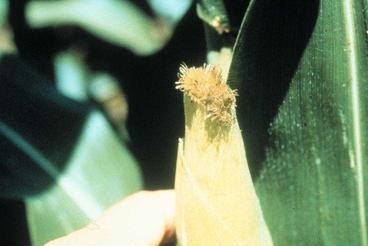
With a few exceptions corn rootworms are only damaging in continuous maize. In some instances, however, economic corn rootworm injury has occurred on maize following small grains (primarily oats), or weedy soybeans, in northeastern Nebraska. Only in rare instances has damage followed in a maize rotation with the other major crops grown in Nebraska. However, in the last few years, the western corn rootworm has altered its behavior to lay eggs in soybean fields in east central Illinois, Indiana, western Ohio, southern Michigan and northeastern Iowa. This behavioral change has reduced the effectiveness of crop rotation for control in these locations. Now it appears that adult western corn rootworms may have further changed their behavior to feed on soybean leaves as well as maize.
The preferred food of the adults (beetles) is maize silks and pollen. However, early emerging western corn rootworm beetles may feed on maize leaves, producing a parchment-like appearance if pollen isn't present. If adults are numerous during the pollination period and silks are chewed into the husks, poorly filled ears may result due to lack of pollination. Depending upon growing conditions, 10-20 beetles per silk mass are usually required to seriously affect pollination. Late planted maize is more likely to be damaged by adults. Most fields are pollinated before sufficient beetles are present to reduce fertilization. When pollination is complete, silks are wilted or turning brown, and then silk feeding is no longer of concern.
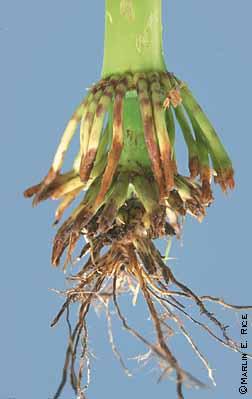
Larvae feed on roots and can cause direct grain losses by reducing both plant stand and vigor. Root pruning (figure right) can also cause plant lodging, which may further reduce yields due to harvest losses. Usually, peak rootworm feeding occurs from late June to mid-July, when all maize roots may be destroyed. The resulting loss of grain may vary widely depending upon the number of larvae per plant, time of planting, available moisture, soil fertility, wind, and general climatic conditions during and immediately following peak injury.
Northern Corn Rootworm
Description
Adults of the northern corn rootworm, Diabrotica barberi are green beetles without any spots or stripes (figure below, left). Adults that have just emerged are very light colored - almost beige. Larvae are creamy-white with a reddish-brown head (figure below, right).
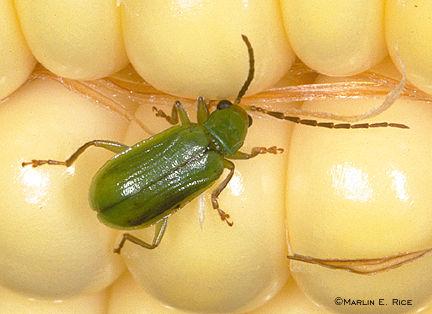
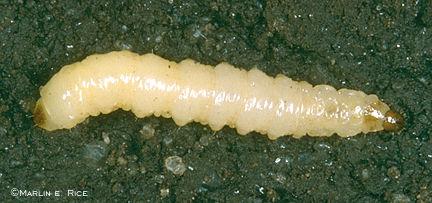
Biology and Life Cycle
The northern corn rootworm was first reported from Colorado. It is now a predominant pest in the Central States (see figure), but is also present in the eastern and southern states. Damage is negligible south of latitude 30o N. The biology and life cycle is similar to that of the western corn rootworm. Female northern rootworm beetles lay up to 400 eggs in the upper 2 to 8 inches of soil during later summer and early fall. Eggs are usually deposited in fields where the adults feed. The eggs hatch the next spring in late May and early June. Some (as many as 30-40%) of the northern corn rootworm eggs may not hatch until the second spring due to an extended diapause. Extended diapause is associated with northern corn rootworms where eggs remain in the soil for two winters rather than hatching in the spring following the first winter. This phenomenon has been identified in Iowa, Minnesota, and South Dakota where corn/soybean rotation has been used for several years. Some of the northern corn rootworm population has adjusted to every-other-year maize planting in those areas.

After hatching, rootworms feed on the underground root systems of maize plants, causing varying degrees of damage ranging from none to complete root destruction. After larvae finish feeding, they change to the pupal stage in which the larva changes into the adult, or beetle stage. They may be active in fields until frost.
Damage
Feeding damage by the larvae is similar to that described for the western corn rootworm. However, the northern corn rootworm adult feeds more on the silk than the western corn rootworm. Also, the northern corn rootworm rarely feeds on the leaves, whereas the western corn rootworm does.
Southern Corn Rootworm
Description
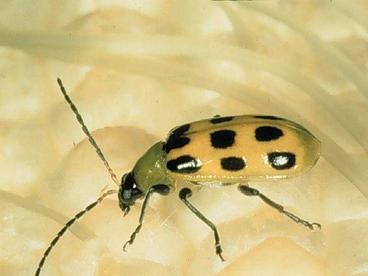
Adults of the southern corn rootworm, Diabrotica undecimpunctata howardi, also known as the spotted cucumber beetle, have 12 dark spots on their yellow or yellowish-green wing covers (see figure). The head and antennae are black. The adults are slightly larger than either the western or northern corn rootworms, being about 6 mm long. The young larvae are slender, white to yellowish, turning to a greenish-yellow color as they mature. The larvae and pupae resemble those of the western and northern corn rootworm. The full grown larva is about 12 mm long and has a brownish head and brown dorsal shield on the ninth abdominal segment.
Biology and Life Cycle
The southern corn rootworm is distributed in states east of the Rocky Mountains, in southern Canada and in Mexico. Adults probably do not overwinter in the northern states but migrate from the south each year and deposit eggs in maize fields in the spring. The southern corn rootworm does enter diapause during the fall in Nebraska. However, overwintering survival is probably minimal and would be most likely to occur in southeast Nebraska. More than one generation of southern corn rootworms occurs each year.
In the southern part of its range, the southern corn rootworm passes the winter in the adult stage. Beetles hibernate in most any type of shelter but prefer the bases of plants that are not killed by frost. They become active early in the spring and migrate northward. The females deposit eggs in the soil around maize plants. Larvae upon hatching bore into the roots of maize plants and the underground parts of the stem. They have two generations per year in the southern states and at least a partial second generation in the North.
Damage
The southern corn rootworm larvae will feed on the roots of many plant species, including maize, soybeans, sorghum, wheat, cucumbers, and other vegetables, and many legumes, but the feeding damage is not serious on maize, except in the southeastern states and southern Texas. Symptoms of larval feeding are holes through the base of small plants, and tillering that follows growing point injury and root injury, similar to that described for the western and northern corn rootworms. On older maize, larval feeding occurs in the base of the stalk, on the young brace roots, and on the lower leaf sheaths. Southern corn rootworm adult feeding is similar to that of the western corn rootworm adults in that they also feed on both the silks and on the leaves.